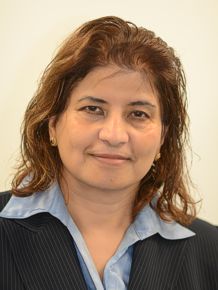Pratibha L Gai
Professor, Dame
Visit Pratibha L Gai's profile on the York Research Database to:
- See a full list of publications
- Browse activities and projects
- Explore connections, collaborators, related work and more
Profile
Career
MSc, PhD (Cambridge), DBE, FREng, FRS
University roles
- JEOL Founding Professor and Yorkshire Forward Chair of Electron Microscopy
- Founding Co Director, the York JEOL Nanocentre
Highlights and Honours
- Fellow of the Royal Society (FRS)
- Fellow of the Royal Academy of Engineering -The National Academy of Engineering, UK.
- L’Oreal-UNESCO Women in Science award as the 2013 Laureate for Europe
- Institute of Physics 2010 Gabor Medal and Prize for in-situ atomic resolution-environmental transmission electron microscopy (ETEM).
- Fellow of Institute of Physics, Fellow of the Royal Society of Chemistry, Fellow of the Royal Microscopical Society, Fellow of the Institute of Materials, Minerals and Mining
Publications
Over 300 refereed scientific papers in leading journals and 9 co-authored and edited books and journal issues, Numerous invited lectures globally. Patented inventions including in hydrocarbon catalysis/polymers, energy sources, electronic ceramics, Piezoelectrics and nanocoatings for polymers and food. The key inventions are implemented in practice bringing societal benefits.
Summary of expertise
- Development of novel chemical processes, nanomaterials, reaction mechanisms and novel in-situ environmental electron microscopy in gases and liquids
- Surface Science and Catalysis for healthcare, energy and climate control
- Angstrom scale aberration corrected in-situ EM, Dynamic atomic processes
Research
Overview
Research Group: Nanophysics
Projects
We are currently engaged in programmes in the following areas:
- Development of aberration corrected in-situ environmental electron microscopy to directly observe atomic scale dynamics in gas molecule-solid surface reactions, in real time;
- Bioenergy production to combat energy shortages and climate change;
- Fuel Cells;
- Heterogeneous catalysis;
- Environmental Nanophysics;
- Nanomaterials and metallic nanoparticles for wastewater treatments, emission control.
- Bio-nanotechnology
- Promoted nanoscale oxides for efficient heterogeneous routes to NSAID pharmaceuticals.
Development of aberration corrected (AC) environmental electron microscopy to probe dynamic processes in gas molecule-solid surface reactions on the atomic scale:
We are developing aberration corrected environmental electron microscopy at the atomic level with a spatial resolution of less than 100 picometers, under controlled conditions of gas and temperature environments. This work follows our pioneering development of atomic resolution-environmental transmission electron microscopy (ETEM) under controlled gas and temperature environments. Applications include capturing atomic scale dynamic events, understanding fundamental mechanisms and the role of defects in nanoscale oxides which are of interest in biofuel technology and catalytic materials. The dynamic nanostructure is being correlated with the performance of the materials. (with Professor E D Boyes).
Bioenergy
Our interests focus on developing economical processes to convert plants and microbials into biofuels. Systematic, dynamic in-situ electron microscopy observations are being carried out to develop efficient routes to biofuels.
Fuel Cells
Fuel cells are an efficient, nonpolluting power source that convert energy from a fuel into electrical energy at low temperatures and reactions take place over nanoparticle catalysts. It is important for the future of earth’s energy reserves that a gradual shift is made away from the fossil fuels to provide electricity. Hydrogen or alcohol powered fuel cells are of considerable interest in different sectors of technology, including in exhaust-free automobiles and in electricity-generating plants. We are investigating nanostructures and performance of a series of new generation fuel cell nanomaterials.
In-situ dynamic aberration corrected environmental electron microscopy in the development of NSAID pharmaceuticals (Paracetamol)
Paracetamol, or acetamenophen (N-acetyl-p-aminophenol) is one of the important non-steroidal anti-inflammatory pharmaceutical drugs (NSAIDS) commonly used. Conventionally it is prepared by homogeneous catalysis. Efforts are under way across the world to find a clean heterogeneous alternative to the current process for NSAIDS using solid acid materials. In-situ AC EM at the atomic scale is being used to understand the dynamic nanostructure of the solid acid materials in the NSAID reaction.
Nanomaterials
- (a) Nanoparticles and Single Atoms
A variety of chemical and process technologies, including fuel cell technology, employ finely dispersed supported metallic nanoparticles or oxides, with a high density of states at the Fermi level. The atomic structure and composition of a number of supported nanoparticles and single atoms are being investigated using AC in-situ electron microscopy combined with (AC) high angle annular dark field (HAADF)-STEM, to obtain a better understanding of their influence on performance. - (b) Three-dimensional nanostructures and specific areas of silver doped-porous titania systems of interest in hydrogen energy and wastewater treatment are being explored using Aberration corrected electron microscopy, electron tomography and modelling (with Nagoya University, Japan).
- (c) The development of nickel nanodots on amorphous silica in the permselectivity for hydrogen separation in reforming reactions for hydrogen production.
- (d) Other programmes include, nanostructures and growth mechanisms of advanced nanostructured materials such as tetrapods, nanowires and nano-twinned metals which exhibit remarkable strength and high structural stability.
Environmental Nanophysics:
Diesel Exhaust:
Diesel fuel, including biodiesel fuel, is widely used throughout our society. It powers vehicles, many other equipment and energy applications. Diesel exhaust is produced when an engine burns diesel fuel. It is a complex mixture of gases and fine particles (including soot). In quantity their effect on our environment and our health is important. The project aims to examine fine particles and their composition in diesel exhaust. Model samples are used first for analysis using scanning electron microscopy (SEM), transmission electron microscopy (TEM) and energy dispersive X-ray spectroscopy (EDX) methods. The research is being used to illustrate the nature of diesel exhaust and contribute to our understanding of possible effects on the environment. (with Professor E D Boyes).
Bio-nanotechnology for biomedical applications
Development of potent antimicrobial agents using nanoscale particles.
Collaborators
Professor J R Weertman, Northwestern University, USA; Dr K Yoshida and Professor N Tanaka, Nagoya University, Japan; Dr C Torardi (USA); Professor M Dresselhaus, MIT, USA; Professor J Calvino (Spain); Professor S Trasobares (Spain); Dr N R Shiju, University of Amsterdam, NL; Professor D R Brown and Professpr J Fieldhouse, University of Huddersfield; Professor K Chattopadhyay, IISc, Bangalore, India; Professor Tyagi and Dr A K Sinha, India; Professor J Goodby; Professor J Thomas-Oates; Professor J Clark; Dr A Hunt; Dr I Saez, Dr A Matharu; Dr E Bergstrom; Professor Thomas and Professor P. Midgley, (Cambridge); Dr D Ozkaya and Dr M Watson; Dr E Ferguson; ORNL (Oak Ridge), Stanford, University of Delaware, ASU, and others.
Support
- European Union
- JEOL
- EPSRC
- Johnson Matthey
- BP
- Japan Society for Promotion of Science
- UKIERI (UK-India Education and Research Initiative).
External activities
Invited talks and conferences
- Royal Society conference on Aberration corrected electron microscopy;
- Royal Society sponsored international conference on industrial catalysis;
- International Microscopy Congress (IMC17-2010) on in-situ Electron Microscopy (EM), Rio de Janeiro, Brazil;
- International Advanced Microscopy and Theory Conference, Nagoya, Japan;
- Electron microscopy conference, University of Cadiz, Spain;
- Indian Institute of Science, Bangalore, India;
- Johnson Matthey Lecture;
- EMAG conference, UK;
- Royal Microscopical Society Lecture, Department of Materials, University of Oxford;
- French Electron Microscopy Congress, Paris, France;
- European Microscopy Congress, Aachen, Germany;
- Chair and organiser of international symposia including in-situ EM symposium at Microscience 2010, London; in-situ electron microscopy at European Microscopy Congress, and Catalytic Materials symposium at IMC17, Brazil.
- Organisation of Cantor Nanoscience lectures with Departments (2009-2010) and arranging visits of chemistry Nobel Laureates to the Nanocentre.
Other Distinctions and highlights
- Development of atomic resolution-ETEM and applications.
- The Atomic resolution-ETEM work featured by American Chemical Society Chemical and Engineering News, Materials Research Society (USA), and by Prof. A H Zewail (Science 2010).
- Fellow of the Royal Microscopical Society
- Japan Society for Promotion of Science Fellowship tenable at Nanocentre (for Doctor Yoshida); UK-India Educational Research Initiative (UKIERI) award; Industrial collaborations with studentships
- Visiting Professor, University of Delaware, USA; Awards from the Royal Society-Paul Instrument fund and Institution of Materials (UK) Metaserv awards for electron microscopy.
- DuPont Global Engineering Excellence Award for Breakthrough in-situ nanocoating technology invention for high strength polymers
- Served on editorial boards of journals and as co-editor and guest editor:
- Microscopy and Microanalysis (Cambridge University Press); Current Opinion in Solid State and Materials Science (Elsevier); Annual Review of Materials Research (USA); Microscopy Research and Technique (Wiley-Blackwell).
- World Technology Network Fellow (New York, USA).

York JEOL Nanocentre
Helix House
University of York
Heslington
York
YO10 5DD
U.K.
pratibha.gai@york.ac.uk
Tel: +44 (0)1904 328403
Fax: +44 (0)1904 328485
Room: Nanocentre

